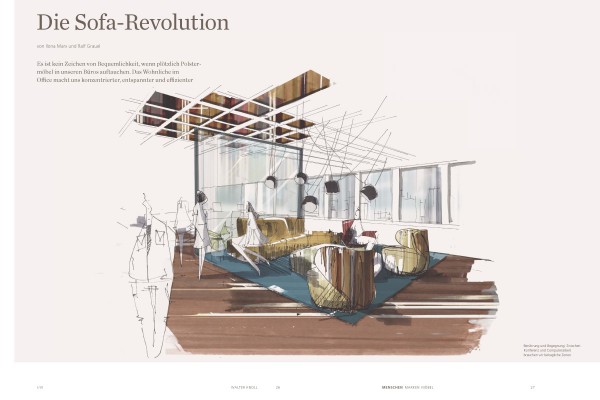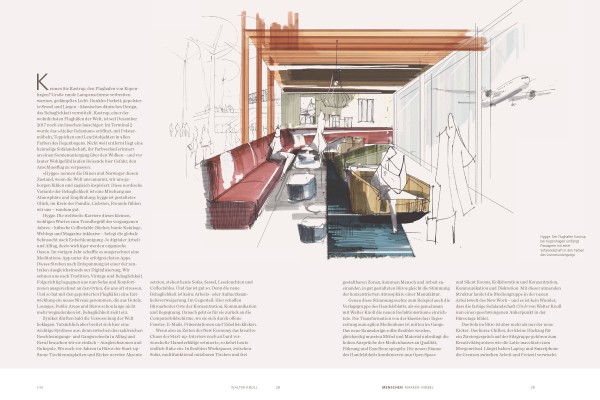Ilona Marx
Editorial work / Concepts / Texts
The sofa revolution
Interior Design
Are you familiar with Kastrup, Copenhagen’s airport? Large, round lampshades diffuse soft, warm light. Dark parquet flooring, upholstered seats and couches – classic Danish design that exudes comfort. Kastrup, one of the coziest airports in the world, was made that bit cozier in December 2017: in Terminal 2, the Atelier Relaxium was opened, with upholstered furniture, carpets and luminous objects in all the colors of the rainbow. Just a stone’s throw away is an inviting sofa landscape, the color scheme of which evokes a sunset above the clouds. Amid this absolute bliss, passengers here run the risk of missing their connecting flight.
“Hygge” is the word the Danes and Norwegians use to describe the feeling of the world hugging you; of being both snug and inspired at the same time. This Nordic variant of coziness is a mixture of ambiance and feeling; hyggeis homemade happiness. With family, friends and loved ones we feel good all around.
Hygge is now the theme of attractive coffee-table books, colorful brochures, weblogs and magazines. The meteoric rise of this small, soothing word to one of last year’s global trending terms is evidence of a universal yearning for deceleration. The more digitalized our work and daily lives become, the more important organic oases become. Last year, a meditation app of all things became one of the most successful apps. The pursuit of relaxation is one of the core trends counteracting digitalization. We long for tradition, vintage and coziness. That is why we are now seeing sofas and comfort zones in places that often cause a lot of stress. And so, with the advent of upholstered airports, the development that had for a long time been an inextricable feature of hotels, lounges, public areas and offices has reached a whole new level.
Cynics might soon be justified in lamenting the cushification of the world. But, actually, what we’re seeing here is the spread of a vital synthesis; because, amid the multitude of acceleration and gear changes in our daily and professional lives, the simple fact is that we need places where we can restore our inner balance and relax. In the rooms where ping pong and foosball tables were once eyed with suspicion years ago in start-up offices, there now stand sofas, armchairs, reading lights and coffee tables today. And that is how it should be. Because this new variety of coziness is not a means for distraction or shirking work. Quite the opposite: office workers are creating places for concentration, communication and encounters. Afterwards, it’s back to the computer screens, where they click their way through open windows, e‑mails, presentations and tables.
While during the new economy era the creative chaos of start-up interiors conjured up images of colorful hamster labyrinths, today, calm has finally set in. People and work come together in flexible workspaces, between sofas, multifunctional tables and areas that can be altered at will. In well-designed offices, the mood is the same as the concentrated atmosphere in a factory.
This was precisely the mood the Handelsblattpublishing group was going for when they set to furnishing their new editorial offices together with Walter Knoll. The transformation from a classic daily newspaper to an agile media company is in full swing. The new interior design had to be more flexible, and the furniture and materials absolutely had to reflect the media company’s high standards of quality, management and excellence. The newspaper’s new rooms combine open space with silent rooms, collaboration with concentration, communication with discretion. This breathing structure landed the media company in the new world of New Work – it’s no wonder the curvy, colorful sofa landscape Circleby Walter Knoll now forms the fulcrum of the office floor.
However, the office sofa is more than just the new foosball table. Taking a little time out and briefly stopping and sitting for a conversation are part of the new creative process – just like the latte macchiato is part of the morning ritual. For a long time now, laptops and smartphones have blurred the boundaries between work and free time. We occasionally like to work from home and, conversely, want to see homey features at work. And so, like an echo, in the era of the home office, elements from home resonate in the office.
Of course, more than just furniture spills over – this also happens with all other tones and topics of a new era: culture and etiquette, democracy, communication at eye level, diversity and welfare. Spending all day and all night in the office has no place in the life model of Generation Y. YOLO (“you only live once”) is not the dictum of the digital natives for nothing. Nowadays, everything must fit – work to live and live to work. The office sofa has become a symbol of mindfulness, appreciation and authenticity.
New Work is me time and we time
At the same time, the upholstered comfort zones create points of contact in the truest sense of the word. In the 1980s, the future still looked bright, and progress was wrapped in plastic and held by a chrome-plated steel tube. But now, because digitalization is changing our lives and it can only be grasped in the form of a smooth screen, we need analog experiences: nature, material, haptics, substantiality. Satisfying the elementary needs of body and soul could become the luxury of the twenty-first century.
However, above all, comfort zones are a spatial representation of the change in work and organization. They give structure to everything that New Work stands for today. Agility, flexibility and diversity are direct responses to acceleration, digitalization and globalization. Projects, teams, targets and processes are so diverse nowadays because the markets are, too. And all these new aspects also mean that we can very rarely fulfill our multifaceted tasks sitting on our posterior all day in the same place.
Sometimes, it requires careful concentration at a computer and other times a relaxed conversation with coworkers, and then sometimes a highly confidential three-way meeting. This can be stressful and can even easily lead to misunderstandings. That is precisely why zones are needed. For relaxation and exchange. For concentration and communication. In this way, office life is normalized into a mixture of me time, we time, sometimes work bench, sometimes marketplace.
As such, for a long time now, high potentials have been assessing a company’s strategy for the future not only based on its furniture but also on its floor plan. The architectural firm Foster + Partners, which already refers to itself as a “workplace consultancy,”has just developed the spectacular European headquarters of the Bloomberg Media Group. Founder Michael Bloomberg has always been an advocate of an open-plan office layout. And so, after years of research, Lord Foster and his colleagues have successfully eliminated footstep sounds and ambient noises to create a virtually limitless open-plan quiet zone. Vast quantities of wood and stone, ten open, curved floors, giant fish tanks, snack bars, and – running in long, flowing curves – upholstered furniture designed by Norman Foster and made by Walter Knoll, create a stimulating and, and at the same time, extraordinarily homey ambiance.
And did Jeff Bezos – Bloomberg’s compatriot who is also lauded as a visionary – not just buy 40,000 plants to create a jungle paradise for his staff in Seattle? The signs are clear: the number of office oases will increase. You could even say that work is becoming hygge. The coziness factor is therefore expected to continue on its upward course. But don’t think that it will make things more boring. At the end of the day, outside our offices, lounges and comfort zones, the world is still out there. And it continues to spin at break-neck speed. As do our jobs.
Ilona Marx
Ilona Marx is a journalist and writes on the interface between the economy and society for the publications brand eins, Lufthansa Exclusive, Edison/Handelsblatt, A&W Architektur & Wohnen, The Weekender, Wallpaper, Focus Style and Port Magazine. Previously, she was editor-in-chief of the fashion magazine J’N’C for twenty years.


